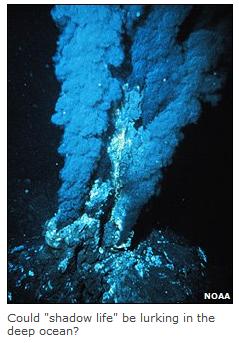 Never mind Mars, alien life may be thriving right here on Earth, a major science conference has heard.
Never mind Mars, alien life may be thriving right here on Earth, a major science conference has heard.
Our planet may harbour forms of "weird life" unrelated to life as we know it, according to Professor Paul Davies, a physicist at Arizona State University.
This "shadow life" may be hidden in toxic arsenic lakes or in boiling deep sea hydrothermal vents, he says.
He has called on scientists to launch a "mission to Earth" by trawling hostile environments for signs of bio-activity.
Weird life could even be living among us, in forms which we don't yet recognise, he told the American Association for the Advancement of Science (AAAS) meeting in Chicago.
"We don't have to go to other planets to find weird life.
It could be right in front of our noses - or even in our noses," said the physicist.
"It is entirely reasonable to expect we will find a shadow biosphere here on Earth.
But nobody has actually taken the trouble to look.
The question is why? The cost is not expensive - it would be a
fraction of the money we spend searching for extraterrestrial life."
'Second genesis'
Professor Davies was one of the speakers at a symposium exploring the possibility that life has evolved on Earth more than once.
 Professor Paul Davies, Arizona State University |
The descendants of this "second genesis" may have survived until today in a "shadow biosphere" which is beyond our radar because its inhabitants have biochemistry so different from our own.
"All our microscopes are customised for life as we know it - so it's no surprise that we haven't found microbes with different biochemistry," said Professor Davies.
"We don't quite know how weird life would look. It's as wide as the imagination and that's why it's really hard to look for."
If it exists, weird life could be based on DNA and RNA - but with a slightly different genetic code or different amino acids.
At the other end of the spectrum, we could find creatures which have more drastic differences.
"Maybe one of the elements life uses - carbon, hydrogen, oxygen, nitrogen, phosphorus - could be replaced by something else," said Professor Davies.
"When I say that, everyone immediately thinks of silicon life - because of Star Trek. But I'm not talking about anything that drastic.
"For example, most of the jobs that can be done by phosphorus can be done by arsenic."
Arsenic may be poisonous to humans, but it has chemical properties which might make it ideal in a microbe's machinery, he said.
'Mission to Earth'
So how do we go about hunting for something we have never seen before?
"There are two possibilities," said Prof Davies, Director of the BEYOND Center for Fundamental Concepts in Science.
 Mono Lake in the US is home to arsenic-fuelled microbes |
"One is that weird life is ecologically isolated, in niches beyond the reach of mankind."
In this case, we must begin trawling the world's most inhospitable environments - deserts, salt lakes, and areas of high pressure, temperature or UV radiation.
"We could have a 'mission to Earth'. There's a big long list of places we could be looking," observed Professor Davies.
"For example, if we are looking for arsenic life, we could head for environments which are both arsenic rich and phosphorus poor - such as deep ocean vents.
"There is also a heavily contaminated lake in California which is arsenic rich - Mono Lake - and we do find microbes in there which get their energy from arsenic.
"But they don't actually incorporate the arsenic into themselves. They spit it back out again. They smoke but they don't inhale."
On the other hand, it could be that "weird life" is actually all around us - intermingled with carbon based life.
"In that case it's going to be really hard to detect - you have to find some way of filtering everything else out."
This laborious process has been used to search for unknown organisms in seawater - by painstakingly filtering everything else away.
If we did discover something unprecedented, "we'd all start arguing" said Professor Davies, a theoretical physicist.
"The question would be whether this life was truly different, or whether there was a common precursor a deep branch on the main tree of life.
"Also, how do we know we are dealing with separate Earth genesis and not a Mars genesis?
"We know rocks do get traded between the two planets, and life could hitch a ride.
"Personally, I'm only interested in establishing whether life happened more than once. If we find it has happened twice from scratch then its going to have happened all around the universe.
"It's going to be teeming with life and there's a very good chance we are not alone."
Life in the lab
Another way to determine what alternative life might look like is to try to invent it ourselves.
If we can create new molecules which can behave in life-like way, we may then go out and look for these in the environment, says Professor Steven Benner, of the University of Florida.
His team have created perhaps the closest yet to a man-made alternative form of life.
"We are announcing the first example of an artificial synthetic chemical system capable of Darwinian evolution," he told the conference.
"Is it alive? Well, I can tell you that it is not self-sustaining.
"You have to have a graduate student stand there and feed it from time to time, but it is evolving."
The molecule is essentially a modified version of our own DNA double helix - but with six "letters" in its genetic alphabet, instead of four.
These nucleotides pair up in strands, which can replicate, though only with the help of polymerase enzymes and heat.
"Sometimes mistakes are made in pairing and these mistakes are maintained in the next generation - it is evolving," said Prof Brenner.
"The next step is to apply natural selection to it, to see if it can evolve under selective pressure.
"The accepted definition of life is a molecule capable of Darwinian evolution, so we are trying to put together molecules that are capable of doing it."
But he questioned whether our definition of "living" is perhaps too "Earth-centric".
"Remember - just because you are a chemical system which is self-sustaining and capable of Darwinian evolution, that doesn't mean that is the universal definition of life," he said.

